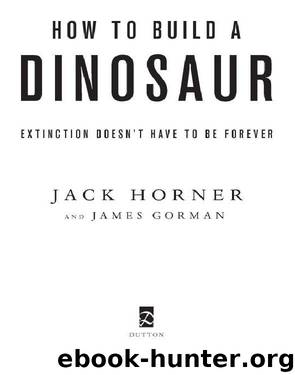How to Build a Dinosaur by Jack Horner

Author:Jack Horner
Language: eng
Format: epub, mobi
Publisher: Penguin USA, Inc.
THE DESCENT OF BIRDS
John did not just discover an unusual dinosaur, he made a comprehensive argument supporting the descent of birds from dinosaurs. In a 1975 article he summed up other views and presented his own argument with evidence to back it up.
First, he noted that the idea that birds were descended from reptiles had long held sway. “Over the years, several different reptilian groups have been suggested,” he wrote, “but for the past fifty years or more the general consensus has placed the source of birds among a group of primitive archosaurian reptiles of Triassic age—the Thecodontia.”
The thecodonts were the precursors of crocodilians, pterosaurs, and dinosaurs. They were land animals that had succeeded some of the huge amphibians that evolved as animal life exploded in its colonization of the land. But, John argued, presenting a thorough and detailed analysis of the fossils of Archaeopteryx, that were available, this bird fossil was so similar to theropod dinosaurs, specifically the gracile, swift, and predatory coelurosaurs, like Deinonychus, that the line of descent to birds was obvious.
He noted similarities in the vertebrae, the forelimb, pelvis, hind limb, and a bone called the pectoral arch. He also dismissed the idea that lack of clavicles or collarbones in theropod dinosaurs meant they could not have given rise to birds, in which right and left clavicles have fused to become what we call the wishbone. Ostrom pointed out that clavicles had indeed been found in several dinosaurs, and that even if they had not been found, negative evidence is never conclusive. Given the rarity of fossils, absence of a characteristic only proves that we haven’t found a fossil with it, or we haven’t noticed it.
In fact, he concluded, the only characteristics that made Archaeopteryx a bird were its feathers and its wishbone. He did not believe Archaeopteryx could fly, and suggested that feathers had evolved for insulation, anticipating that other, nonavian dinosaurs would have evolved feathers. Without those two characteristics the skeleton would have been classified as a theropod.
Now is a good time to tackle how such classifications are made. When Ostrom was publishing his work he was tracking descent, a fairly straightforward idea, which led to evolutionary trees much like family trees. Instead of parents and great-grandparents , you would have parent species or genera and great-grandparent species or genera. But genealogy and phylogeny were both alike in that they traced actual descent, trying to establish who fathered cousin Fred and what particular genus of dinosaur gave rise to the first birds. They were, in effect, using the same charts.
Gradually this has been supplanted by cladistics, which is significantly different—even revolutionary—in how it changes the way we think about the past. Cladistics is used not to track ancestors, as in genealogy, but as a way to look at the changing characteristics of organisms over vast stretches of time. It abandons the search for a specific ancestor to any species or genus. Instead it tracks evolutionary change by looking for new characteristics, like feathers or hair or walking on two feet.
Download
This site does not store any files on its server. We only index and link to content provided by other sites. Please contact the content providers to delete copyright contents if any and email us, we'll remove relevant links or contents immediately.
| Paleobiology | Paleozoology |
| Vertebrate |
Sapiens: A Brief History of Humankind by Yuval Noah Harari(14327)
The Tidewater Tales by John Barth(12629)
Mastermind: How to Think Like Sherlock Holmes by Maria Konnikova(7281)
Do No Harm Stories of Life, Death and Brain Surgery by Henry Marsh(6910)
The Thirst by Nesbo Jo(6882)
Why We Sleep: Unlocking the Power of Sleep and Dreams by Matthew Walker(6661)
Life 3.0: Being Human in the Age of Artificial Intelligence by Tegmark Max(5520)
Sapiens by Yuval Noah Harari(5328)
The Longevity Diet by Valter Longo(5044)
The Body: A Guide for Occupants by Bill Bryson(5035)
The Rules Do Not Apply by Ariel Levy(4913)
The Immortal Life of Henrietta Lacks by Rebecca Skloot(4552)
Animal Frequency by Melissa Alvarez(4431)
Why We Sleep by Matthew Walker(4398)
The Hacking of the American Mind by Robert H. Lustig(4342)
Yoga Anatomy by Kaminoff Leslie(4336)
All Creatures Great and Small by James Herriot(4277)
Double Down (Diary of a Wimpy Kid Book 11) by Jeff Kinney(4245)
Embedded Programming with Modern C++ Cookbook by Igor Viarheichyk(4145)
